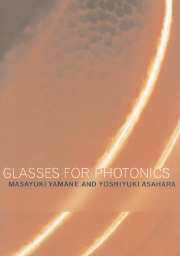3 - Laser glass
Published online by Cambridge University Press: 30 July 2009
Summary
Introduction
The laser is a source of monochromatic radiation of high intensity, coherence, and directionality, in the ultraviolet, visible and infrared optical region. The many and varied applications of lasers include laboratory use, research (optical spectroscopy, holography, laser fusion), materials-processing (cutting, scribing, drilling, welding, abrasion), communications, information processing, military (range finders, target designators), and medical use [1]. Glass plays many varied roles in rare-earth laser systems, because glass can be made with uniformly distributed rare-earth concentrations and has great potential as a laser host medium. In addition, rare-earth doped fibers have received growing attention recently. They could have many uses as amplifiers in optical communication systems and as optical sources. Glass waveguide lasers are another interesting subject for the development of compact laser sources and amplifier devices.
This chapter concentrates on laser glass materials containing rare-earth ions, thus excluding crystalline laser materials. To provide an understanding of the properties of laser glass, the chapter begins with a brief summary of the fundamental physics of lasers in Section 3.1. To explain the characteristics of bulk laser glass, representative laser parameters and their host dependences are summarized briefly in Section 3.2. The recent developments of fiber lasers (in Section 3.3) and glass waveguide lasers (in Section 3.4) are reviewed.
Fundamentals of laser physics
Stimulated emission [2, 3]
It is well known that atoms, ions and molecules can exist in certain stationary states, each of which is characterized by levels of the atomic system called quantum numbers.
- Type
- Chapter
- Information
- Glasses for Photonics , pp. 82 - 158Publisher: Cambridge University PressPrint publication year: 2000
- 1
- Cited by



